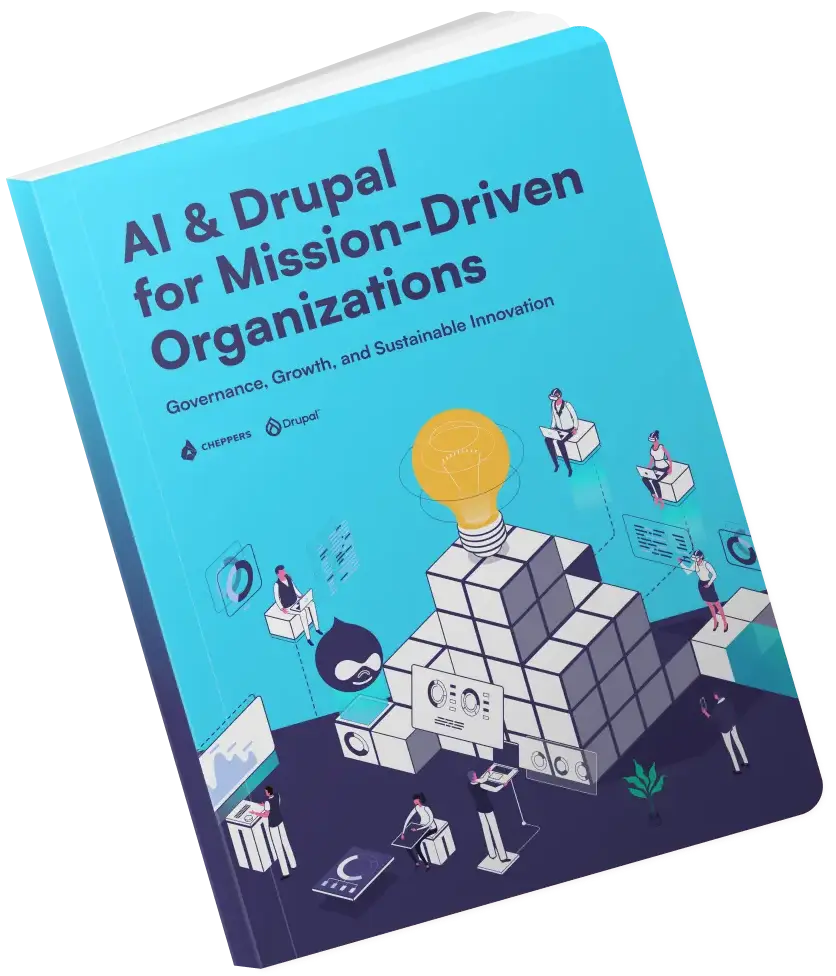Drupal: The CMS for Responsible AI
Artificial intelligence has become one of the defining conversations of our time. Some see it as a revolutionary force with limitless potential, while others think it is a looming threat, raising concerns about control, jobs, and trust. For leaders, product teams, editors, and developers, the real question is simpler and more practical: how can AI help people focus on the work that matters while handling the repetitive tasks?

Teams want faster publishing, clearer communication, and better user experiences. The most reliable way to get there is to treat AI as a collaborator rather than a competitor. Automated systems can take on repetitive or data-heavy tasks, while people contribute judgment, empathy, ethics, and creativity. This article explains how that looks in real teams and why Drupal is a powerful platform for building AI-enhanced experiences with control and accountability.
If you work in the nonprofit space, we also published a focused guide, AI & Drupal for Mission-Driven Organizations, that applies these ideas to social impact teams with extra depth on transparency and community trust.
Why Drupal Is the Right Foundation
Many platforms promise AI integration. Drupal stands out because it gives teams freedom, structure, and community support.
Freedom comes from open source and a modular core. There is no lock-in. AI shifts quickly. Prices, policies, and capabilities change month to month. You can choose the AI services that fit your needs and budget, swap providers easily as policies or prices change, and keep ownership of your data.
Structure comes from content modeling and APIs. Content types, fields, taxonomies, and workflows are machine-readable, which means AI can translate, summarize, tag, or recommend with context and then hand results back into editorial flows. The great thing about this is editors do not need to change how they write; they can keep creating articles and other content the same way as before.
Community closes the loop. The Drupal AI ecosystem is advancing through public contributions, shared patterns, and the backing of dedicated organizations. Drupal is leading the way in bringing AI into open source and content management, and it’s remarkable to have a community and partners driving this progress together. We believe AI is at its best when it supports people rather than trying to take their place, and that perspective makes both the community and the technology especially valuable.
Drupal Patterns That Make AI Useful
Certain patterns deliver value quickly because they align with how people already use Drupal (and AI). Suggestions appear where editors already work, move through the same moderation workflow, and leave a full revision trail. Teams can start with a couple of patterns, measure the impact, and expand once the flow is trusted.
- Editorial acceleration:
In the editing screen, AI can draft summaries, propose headlines, expand thin sections, and rewrite content in a chosen tone. Suggestions appear alongside your content, either in a popup or in the sidebar, so you can insert, adjust, or ignore them without leaving the page. Many teams add an AI review step that scores clarity and completeness, leaves comments on weak sections, and suggests concrete edits before the final human review.
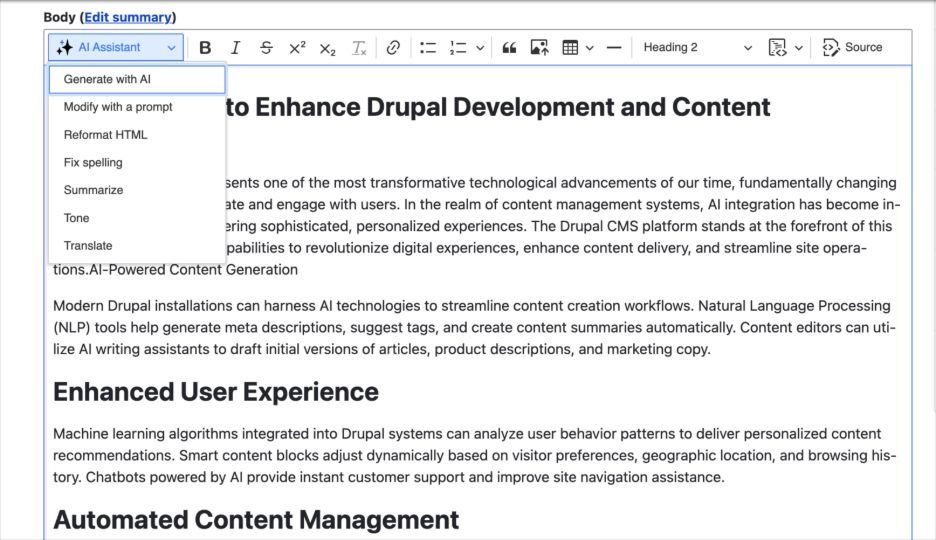
- Metadata and SEO:
Titles, descriptions, social previews, and image alt text still matter, even as search shifts toward AI answers and richer discovery surfaces. As outlined in our post on how SEO is changing, visibility now rests on strong metadata plus structured, genuinely valuable content. In Drupal, AI can fill these fields directly where you manage them, so nothing is left blank or inconsistent. Editors then can review and adjust facts, validation rules catch mistakes, and your pages present well in classic search, social shares and AI-driven results as well. - Taxonomy and tagging:
Tags and categories come from your controlled vocabularies. AI reviews the draft and suggests terms from those lists, or proposes new ones if that option is enabled, based on the actual content rather than random keywords. You decide what applies. Because Drupal’s taxonomy is structured, consistent tagging strengthens topic hubs, related links, search, newsletters, and personalized experiences across the site.
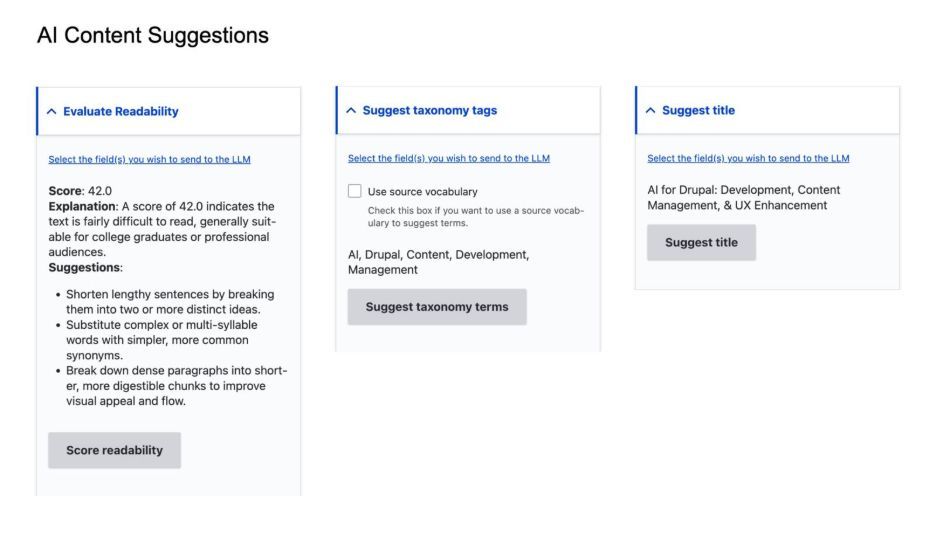
- Accessibility:
Alt text and transcripts live on media items in Drupal. AI can automatically create a solid first draft for each media entity. Editors review for accuracy and context, then save. As WCAG expectations grow, this approach improves accessibility coverage while keeping work manageable and auditable. - Multilingual publishing:
Multilingual publishing becomes easier when AI generates translation for the original content. Editors then review the drafts, refining terminology and tone before publishing. This removes copy-paste work and keeps updates synchronized across languages. - Search and discovery:
On a Drupal site, AI can make search feel smarter and more helpful. Instead of matching only exact keywords, semantic search understands intent, rewrites vague queries, handles typos and synonyms, and boosts results that fit what the user meant. With retrieval-augmented generation (RAG), the system can also pull the best passages from your indexed nodes and return a short, cited answer that links back to the right pages. We will dive deeper into AI search with RAG in Drupal in an upcoming post. - Site-aware assistance:
A small help widget or chat can answer questions using only your current, published pages, and it links to the exact section it used. If the question is complex or sensitive, the assistant routes the person to a form or support inbox, or a real person to join the chat, the workflow can be different for each organization. Logs show which answers worked well so editors can strengthen weak pages, and fine-tune chatbots. Because Drupal exposes structured fields, the assistant can reference the precise paragraph rather than a whole page.
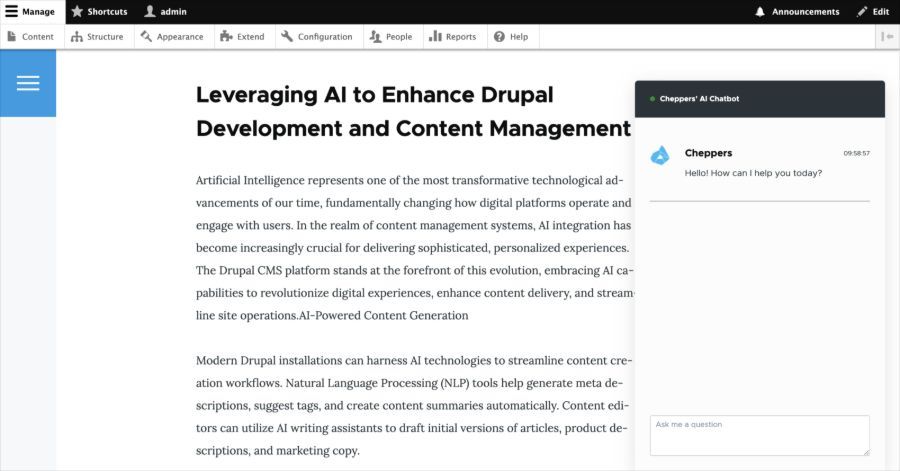
Clear rules make these patterns work. Once you decide where AI should help, the real advantage comes from defining a workflow that fits your organization, setting who can trigger it, when outputs can be saved, and what requires review before anything goes public. Drupal turns those guardrails into configuration rather than policy notes, giving you control inside the product itself. Within that framework, you can also assign different agents for different jobs, such as a translator, a content generator, an SEO assistant, a reviewer, and others, while people remain visibly accountable for what is published.
Keeping People in Charge
Speed only matters when teams remain responsible for what ships. In Drupal, human oversight is built in rather than bolted on. Roles and permissions define who can use assistants, which fields they may touch, and which content types they can affect. When configured, moderation states can require the necessary reviews, such as editorial, legal, or product, between a suggestion and publication, so nothing goes live without the necessary checks you require. Revisions and diffs show exactly what changed, who approved it, and when it went live, which makes rollback simple if something misses the mark. Environment and scope controls limit where AI can run and what data it can see, aligning usage with privacy and compliance. At the end, the product enforces the promise: people make the final call, and the platform records how that decision was made.
The Importance Of (mutual) Review
We opened with a simple premise: treat AI as a collaborator, not a competitor. Mutual review is how that principle becomes practice. AI is fast and tireless but probabilistic; it can be confident and wrong or miss nuance. People bring context, ethics, and judgment, yet we also make mistakes and drift from a consistent voice and editorial standards. The best results appear when AI reviews people for clarity, completeness, and pattern breaks, and people review AI for accuracy, tone, intent, and risk.
In Drupal this collaboration is practical. Assistants can scan older posts, flag outdated facts, broken links, thin sections, missing alt text, and stale metadata, then propose specific fixes with reasons. Editors see a prioritized queue, open a diff to inspect changes, and approve or adjust with a single save. The same workflow can start from the other direction. AI can turn a brief or structured fields into a brand-new draft, save it as an unpublished node in a “Needs review” state, and route it to the right editor. Every step is logged, so you gain speed while keeping responsibility.
Make Your Content AI-Ready
A clear content model turns AI from a demo into a useful tool. When Drupal describes content clearly, assistants understand context and produce suggestions that are specific, reviewable, and consistent with your voice. Clean fields and vocabularies make search, translation, accessibility, and personalization work better because the model sees the same signals your editors use. Provenance and revision history build trust by showing where information came from and how it changed. Guardrails on sensitive data reduce risk, while clear workflows keep accountability visible. In short, good structure makes AI faster, safer, and easier to approve, which is why it belongs at the center of any Drupal AI plan.
Conclusion: Start small, Measure, and Grow
Pick one high-leverage job. Summaries are a common win. Define what “good” looks like, enable the assistant for a single content type, and run for two weeks. Measure time to first draft, edits required, and page performance. Keep what works, tune prompts, and drop what does not. Then add a second job such as translation drafts for key pages or first-pass alt text for new media, with one safeguard per job. Share the results so everyone sees the value.
AI helps when it clears friction and amplifies human judgment. Drupal makes that practical. Structured content gives models the right signals, APIs provide clean integration points, and workflows keep people in control. Start small, prove the benefit, and expand with confidence without rebuilding your site or breaking trust.
If you work in the nonprofit sector and want detailed, step-by-step guidance fitted to your teams and/or organization, check out our book AI & Drupal for Mission-Driven Organizations.
Related posts

Search is no longer what it used to be. For many years the process was simple. People typed a question into Google, browsed the links that appeared, and clicked the result that looked most promising. Businesses, especially those running Drupal websites, built entire strategies around search engine optimization to capture those clicks and grow their audience.
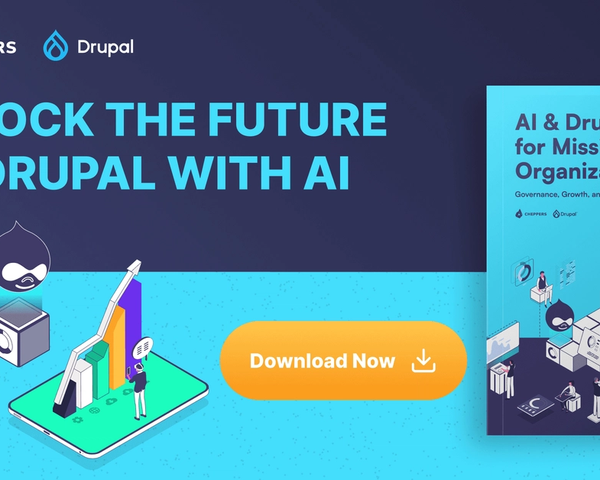
If you’ve been following this blog for a while, you may have noticed it’s been quieter than usual. That pause wasn’t because I ran out of things to write about. On the contrary, it was because I was writing something bigger, something that needed a different format than a single post or even a series of posts. That project became an e-book, AI & Drupal for Mission-Driven Organizations, and I’m happy to finally share it with you.

